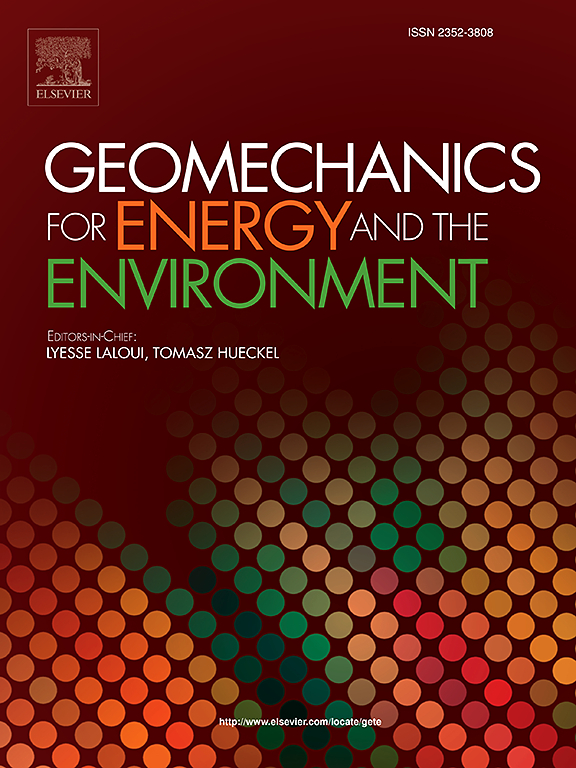从纳米压痕测量腐殖质和腐泥质煤的断裂特性和蠕变行为
IF 3.3
2区 工程技术
Q3 ENERGY & FUELS
引用次数: 0
摘要
煤及其矿物的裂隙性质和蠕变行为在煤炭开采勘探、水力压裂作业、提高(强化)煤层气开采效率、地质固碳技术的实施以及深部煤地下气化技术等方面发挥着至关重要的作用。以往的研究主要集中在杨氏模量和硬度等微观力学参数上,而有机显微物如何影响煤的断裂性能(断裂韧性(Kc)、脆性指数(B))和蠕变行为目前尚不清楚。利用x射线衍射、拉曼光谱和纳米压痕技术对腐泥煤和腐殖质煤的微观结构、断裂性能和蠕变行为进行了研究。结果表明:不同煤种的断裂参数(Kc和B)的变化与硬度和杨氏模量的变化相似;腐殖质煤的脆性指数和蠕变参数(粘弹性参数E1、E2、η1和η2)以及接触蠕变模量(C)均高于腐泥煤。此外,煤的断裂参数(Kc和B)和蠕变参数(E1、E2、η1、η2、C和蠕变应力指数(n))的减小顺序为:惰质组>; 镜质组>; 藻质组。说明脆性较低的腐泥煤和褐藻煤更容易发生蠕变。煤显微组织的微断裂和蠕变参数的变化主要是由其化学结构决定的。本研究提高了对微观尺度下煤及其基质的断裂特性和蠕变行为的认识,将为煤层压裂优化提供理论指导,阐明煤的蠕变机理。本文章由计算机程序翻译,如有差异,请以英文原文为准。
Fracture properties and creep behavior of humic and sapropelic coals from nanoindentation measurements
The fracture properties and creep behavior of coal and its macerals play a critical role in coal mining and exploration, hydraulic fracturing operations, improving the efficiency of (enhanced) coalbed methane recovery, the implementation of geological carbon sequestration technology, and deep underground coal gasification technology. Previous researchers have mainly focused on micromechanical parameters such as Young's modulus and hardness, while it is currently unclear how organic macerals affect their fracture properties (fracture toughness (Kc), brittleness index (B)) and creep behavior of coal. Here, X-ray diffraction, Raman spectroscopy, and nanoindentation were used to investigate the microstructure, fracture properties and creep behavior of sapropelic and humic coals. Results show that the variation of fracture parameters (Kc and B) is similar to the variation of hardness and Young's modulus for different coal macerals. Humic coal exhibited higher brittleness index and creep parameters (viscoelastic parameters (E1, E2, η1, and η2), and contact creep modulus (C)) compared to sapropelic coal. In addition, the fracture parameters (Kc and B) and the creep parameters (E1, E2, η1, η2, C, and creep stress exponent (n)) of coal macerals decrease in the order: inertinite > vitrinite > alginite. This suggests that the sapropelic coal and alginite with lower brittle were more prone to creep. The changes in the microfracture and creep parameters of coal maceral are mainly determined by its chemical structure. This study improves the understanding of the fracture properties and creep behavior in the coal and its matrix at the micro scale, which will provide theoretical guidance for optimizing coal seam fracturing and shed light on the creep mechanism of coal.
求助全文
通过发布文献求助,成功后即可免费获取论文全文。
去求助
来源期刊

Geomechanics for Energy and the Environment
Earth and Planetary Sciences-Geotechnical Engineering and Engineering Geology
CiteScore
5.90
自引率
11.80%
发文量
87
期刊介绍:
The aim of the Journal is to publish research results of the highest quality and of lasting importance on the subject of geomechanics, with the focus on applications to geological energy production and storage, and the interaction of soils and rocks with the natural and engineered environment. Special attention is given to concepts and developments of new energy geotechnologies that comprise intrinsic mechanisms protecting the environment against a potential engineering induced damage, hence warranting sustainable usage of energy resources.
The scope of the journal is broad, including fundamental concepts in geomechanics and mechanics of porous media, the experiments and analysis of novel phenomena and applications. Of special interest are issues resulting from coupling of particular physics, chemistry and biology of external forcings, as well as of pore fluid/gas and minerals to the solid mechanics of the medium skeleton and pore fluid mechanics. The multi-scale and inter-scale interactions between the phenomena and the behavior representations are also of particular interest. Contributions to general theoretical approach to these issues, but of potential reference to geomechanics in its context of energy and the environment are also most welcome.
 求助内容:
求助内容: 应助结果提醒方式:
应助结果提醒方式:


